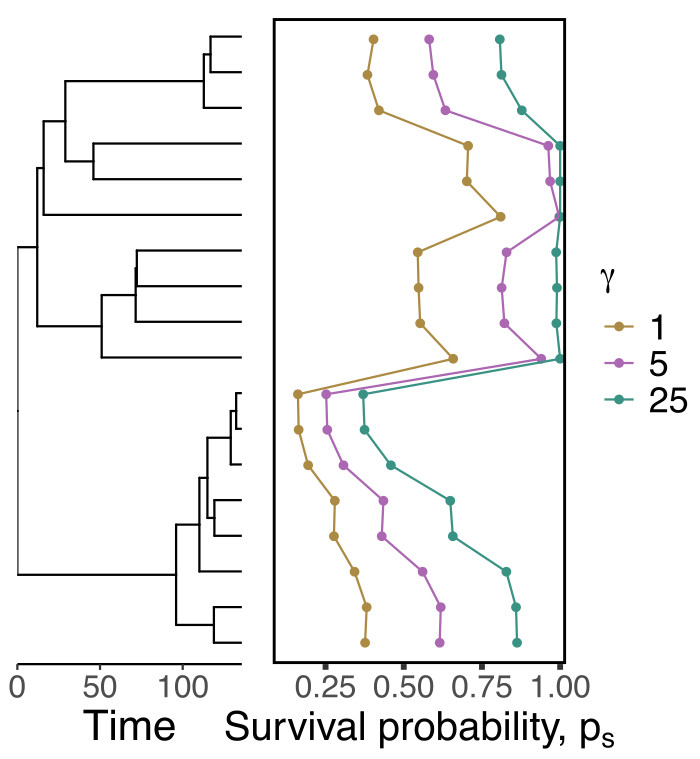“Effects of Phylogeny on Coexistence in Model Communities”
Carlos A. Serván, José A. Capitán, Zachary R. Miller, and Stefano Allesina: Read the article
A membership society whose goal is to advance and to diffuse knowledge of organic evolution and other broad biological principles so as to enhance the conceptual unification of the biological sciences.
Posted on
by
Carlos A. Serván, José A. Capitán, Zachary R. Miller, and Stefano Allesina: Read the article

In ecosystems that comprise multiple competing species, who gets to stay? You’d think that species fighting for the same resources would settle things by who is toughest, but nature plays by stranger rules.
Imagine a forest filled with different plants and creatures that coexist. They are constantly competing for the same resources—like trees drawing nutrients from the same patch of soil. So why don’t we see just one “strong” species that uses the resources the best spread and outcompete all the other species? How can they coexist? This raises another question: does having many species that share the same resources and coexist affect how the whole community works? For example, if instead of a forest filled with lots of tree species, there was just one tree species, would they produce the same amount of oxygen?
To explore such questions, scientists at the University of Chicago built a mathematical model to understand how species interactions are shaped by their similarity in traits and shared history. They use this model to answer three broad questions: (1) Does similarity in traits make species more likely to compete rather than cooperate? (2) Does this competition affect how productive the overall community is? (3) What factors determine which species survive in a community?
Scientists have hypothesized that communities are shaped by two key principles. The first of these is that if species have very similar traits, they are more likely to compete for the same resources, and stronger competitors will eventually drive weaker ones to extinction—this is also known as competitive exclusion. The second principle is that a species survives based on how optimally it adapts to its environment, also known as environmental filtering. These contrasting forces can lead to very different outcomes and community compositions. When competitive exclusion is dominant, we end up with a community of distantly related species that have very diverse traits. When environmental filtering is dominant, we end up with species with similar traits coexisting, because they’ve all adapted to the same environment.
The authors built the model to test which rules nature actually follows when deciding who gets to stay in the community. In this model, trait values of species evolve over time, and some traits are similar for closely related species. The more similar the traits, the more the species compete; hence, the species have to find ways to specialize or use different traits to reduce competition. The authors tested different scenarios and validated their predictions using real world biodiversity data from grasslands.
Using their model, the authors were able to validate the expected results and found that when the number of traits is much larger than the number of species, species specialize, reducing competition. They also found that with more shared evolutionary history and more similar traits, competition increases between species, reducing the number of species that can coexist within a community. These results align more closely with the principle of competitive exclusion, where similarity drives exclusion, than with environmental filtering, which typically favors coexistence of similar, well-adapted species.
Based on these results, we’d expect competing species to have an equal likelihood of inclusion in a community, and which species gets to stay is random. However, the model revealed a surprising result: species that develop new traits early, or the “elders” of the group, were more likely to survive. This suggests that these “elders” had more time to develop more unique traits, resulting in them having less competition with others and a greater likelihood of persisting in the community. Even more unexpected was that communities with just a few of these early-innovator species are more productive than communities with a large diversity of species. This challenges the notion that more diverse communities are more productive.
Overall, this study provides a mathematical model for understanding how species interact in a community, how biodiversity works, and why some species stick around while others don’t. This paper also shows that communities don’t form randomly, and the evolutionary history of interacting species plays a key role in determining community composition. There are rules, although complex and unexpected, that determine which species tend to live together. And most importantly, the composition of the community determines its output as well. These insights help us understand community dynamics, which is at the heart of many efforts, including preserving biodiversity, conserving ecosystems, and predicting the effects of environmental changes on community productivity.
Deepika Gunasekaran is a postdoctoral scholar at University of California, Merced, in Dr. Clarissa Nobile’s lab. She is a computational biologist, and her work focuses on developing computational methods to study gene expression and epigenomics, aiming to understand the mechanisms and evolution of fungal pathogenesis. In her spare time, she enjoys reading historical fiction, painting, and traveling.